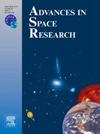Multi-scale fusion pixel and instance contrastive self-supervised learning for semantic segmentation of high-resolution Earth surface images
IF 2.8
3区 地球科学
Q2 ASTRONOMY & ASTROPHYSICS
引用次数: 0
Abstract
In the field of remote sensing (RS) image semantic segmentation, existing supervised learning methods rely on a large amount of labeled data, which limits their application scope. To solve this problem, we propose a new self-supervised learning method, called multi-scale fusion pixel and instance contrastive learning network (MPINet). This method first uses focal frequency loss to optimize the learning of high-level semantic information, and then strengthens the spatial information in the shallow feature map through multi-scale fusion pixel contrast learning, thereby improving the model’s ability to mine detailed features. Experiments are conducted on the International Society for Photogrammetry and Remote Sensing (ISPRS) Potsdam, LoveDA and UAVid datasets. The results show that our method achieves 49.89%, 70.98% and 63.55% in mIoU, OA and mF1 indicators on the ISPRS Potsdam dataset, which is 1.48%, 1.71% and 0.95% higher than the best method. On the LoveDA dataset, our method achieves 38.05%, 52.89% and 54.10% in mIoU, OA and mF1 indicators, which is 0.6%, 0.91% and 1.04% higher than the best method. On the UAVid dataset, our method achieved mIoU, OA, and mF1 scores of 57.92%, 76.97%, and 73.28%, respectively, representing improvements of 1.06%, 1.46%, and 1.15% compared to the best method. Experimental results show that the proposed method outperforms the existing optimal self-supervised learning method and the ImageNet pre-training method.
求助全文
约1分钟内获得全文
求助全文
来源期刊

Advances in Space Research
地学天文-地球科学综合
CiteScore
5.20
自引率
11.50%
发文量
800
审稿时长
5.8 months
期刊介绍:
The COSPAR publication Advances in Space Research (ASR) is an open journal covering all areas of space research including: space studies of the Earth''s surface, meteorology, climate, the Earth-Moon system, planets and small bodies of the solar system, upper atmospheres, ionospheres and magnetospheres of the Earth and planets including reference atmospheres, space plasmas in the solar system, astrophysics from space, materials sciences in space, fundamental physics in space, space debris, space weather, Earth observations of space phenomena, etc.
NB: Please note that manuscripts related to life sciences as related to space are no more accepted for submission to Advances in Space Research. Such manuscripts should now be submitted to the new COSPAR Journal Life Sciences in Space Research (LSSR).
All submissions are reviewed by two scientists in the field. COSPAR is an interdisciplinary scientific organization concerned with the progress of space research on an international scale. Operating under the rules of ICSU, COSPAR ignores political considerations and considers all questions solely from the scientific viewpoint.
 求助内容:
求助内容: 应助结果提醒方式:
应助结果提醒方式:


